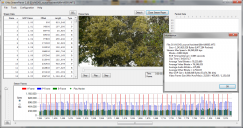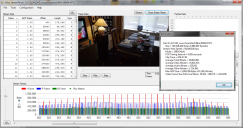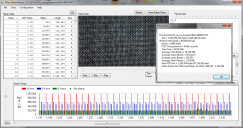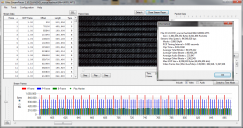
Please, support PV!
It allows to keep PV going, with more focus towards AI, but keeping be one of the few truly independent places.
It allows to keep PV going, with more focus towards AI, but keeping be one of the few truly independent places.
AVCHD maximum image quality settings and testing
-
Ok thanks,
I could not find a post with anyone having an issue with Chris 66M AQ2 other than someone who was trying 50i and another using a UHS-1 card. -
@proaudio4 '...BUT, on a static scene using pappas death chart, streamparser chart developed a cadence issue after about one minute.' can you post up the chart for this if u havent already? thnks
-
@driftwood
Your "Beautiful buffers Final - Stable Max settings" spans correctly in 24p L mode if you down the bit rate from 110000000 mbits to 66000000. This is the only setting that I have modified. I'm getting five or six 4 GB files wich runs correctly in Windows Media Player. Premiere import this files without any problem also!! -
@paglez Looks like a nice result - Ill test it later on the buffers chart. Good to have a great top setting and a nice mid range spanable setting. defo sure the quality is good?
-
I forget to mention that my SD card is 32 GB Sandisk Extreme Pro 45 Extreme Pro 45 MB/s.
-
OK drift,
I don't believe I still have the file, but it's easy enough to try again.
You are refering to your 88M/66M AQ2 (24 video buf:3600000), right?
Since, I'm 100% confident I will also see the cadence issue again, do you have any idea
how I can make this work without a cadence issue? The T4 to T1 trick fixed the cadence issue, but
I-frames drop after a bit on the static extreme test. Stray has seen the same issue using T4 to T1
Also, I'd really like to see a working (no cadence, no i-frame drop, no crash,) on 24H 88M AQ3.
I want to see how well I-frames hold up on motion. -
yeah, its cus im busy on other tests at mo... I just wanna know at what point it failed for the spreadsheet!
-
ok.
Also, since we all know the noise is seen as motion, with this in mind it may be easier to come up with repeatable tests.
One problem in making comparisons, if someone uses apples, then someone else uses fucking oranges.
I set up a couple daylight lamps in a dark room where I place the chart.
I also have a motorized base for my tripod so I can get repeatable motion for motion testing.
I also have a dense graph chart that does not max out the I-frames.
With this in mind using my 14-140mm zoomed to frame the chart (static test), I target ISO 3200 at 1/1600 shutter speed.
The high noise tends to bring up the b,p frames for motion vector and lowers the I-frames. As I lower the ISO
the I-frames get larger. This is easily repeatable and can be measured easily by streamparser.
So having said that, this is a repeatble test that can evaluate bitrate distribution between b,p, and i frames.
This will make it a lot easier (for me) to compare what affect the bitrate and AQ settings are having on the bitstream when capturing a repeatable static test (with high ISO, and with low ISO)
What I'd like to know more is on the buffer settings and limits. If anyone has any info they can share, please let me know.
My goal (and many others I'm sure) is to find the best setting that can hold the I-frames to a decent level under higher motion. Now, since we know noise is offering a repeatble amount of motion, this can be a great tool for analyzing differences.
Like I mentioned, I also have a motorized base which can also backup some of my findings for motion.
-
change frame limits ever so slightly taking off only a very small percentage per test. The reason why I say this is as Im seeing more stable results with changes. Im testing right now if quality is badly affected if you trim reference frames by a small proportion to maintain writeability.
-
@driftwood Very cool, I saw the discussion on this in the low GOP thread. Question though, as you cange the FBs and Frame limit a lot less than their defaults (not a bitrate related multiple) do you still keep the ratio the same accross them ? I mean, if you multiply the FBs by 1.2 do you also multiply the frame limit by 1.2 ? The discussion seems to suggest that there is a top frame limit, irrespective of bitrate, that there is no point going past.
Edit : Er.. I've worked it out, ignore this. -
#Driftwood Just tried your 720p latest settings on a test shoot of Las Vegas show.Low light looks very well. Bravo...
-
@proaudio4 I think I'm there with 88M AQ2 (havent tested this fully on AQ3 yet but it seems okay). I've taken the approach chris has used in the max variation patch.
Can you give it a whirl on the extreme ISO/SS test again? I've done the test, I did get the cadence problem but it appears fixed now. Just want to make sure that I got the conditions right really. I've pulled the frame limit down a fair way, I've not seen it go over 1.060 MB with these settings (which is a way off the hard limit of 1.180). It may be possible to tweak it a bit higher again, which I havent tried since increasing the video buffer to 36000000. Can't do much more on this now for a few days as I have some compositing work to catch up on. I've put up some of the streamparser outputs from the tests. Have you had any luck with an 88M ?
 detail_slowpan AQ2 88M.png1296 x 682 - 471K
detail_slowpan AQ2 88M.png1296 x 682 - 471K
 handheld AQ2 88M.png1293 x 682 - 401K
handheld AQ2 88M.png1293 x 682 - 401K
 ISO800 125 AQ2 88M.png1294 x 681 - 468K
ISO800 125 AQ2 88M.png1294 x 681 - 468K
 ISO3200 1600 AQ2 88M.png1295 x 681 - 423K
ISO3200 1600 AQ2 88M.png1295 x 681 - 423K
 setg.zip502B
setg.zip502B -
Thanks Stray.
I'm strapped until this Friday.
Wow,
Without picking apart your ini file, what did you change?
Impressive!
I'll test it out and post my results. -
I shrank the FB1 buffers back to default like the max variation patches, and tweaked and tried a lot of different hi/low top bottom settings before settling on these (although I've still no idea what they actually effect tbh, it seemed to effect stability). I also shrank the frame limit considerably, as was discovered and discussed by chris and driftwood (in the low GOP thread I think) a mad high frame limit causes buffer overflows and underruns. Also, like chris I have never seen an I-Frame larger than 1,180,000 so pushing it seems to be pointless at the moment. As I said though, its running with I-Frames considerably lower in size to that, and as I've increased the video buffer from default to 3600000 there may be some headroom to tweak that up a bit. I don't think its ever going to be worth pushing it higher than x1.4 though. It also seems stable at AQ3 (changing nothing but the AQ), but really need to test that properly still. Also I've not really fully tested the 24L setting, and maybe that could be put up to 66M although that extra 2M isn't, I think, going to make a worthwhile difference really.
Edit : I may have done some other things I can't remember right now, it's busy and I'm all over the place here. If anything else occurs to me I'll post about it later. Did do a lot of tests on settings before taking the max variation approach, and I did have that originally running ok on a 2400000 buffer before bumping it up (it was a cautionary decision). -
Regarding the GOP1 220M AG2 setting. I've been shooting the last days with these settings. They are indeed amazing but have problems when converting. Some will convert through "log and transfer" some not. The frame reordering happens with me only on my Sandisk U1 45mb card and not on the Transcent class10 card. Same for the 220M GOP1 AQ1. Can it be something with the formatting and is their a program where we can put the right formatting? I found this link: http://www.sdcard.org/consumers/formatter_3/ will try it know.
-
Hi guys,
Questions: With the hack in general, do you experience any problems when doing log & transfer in FCP7? Does it matter what setting you're running for example driffwood GOP1 220M AG2 or cbrandin... settings? Lastly, any ways around the log & transfer problems in FCP7 or any additional software that will work?
Thanks -
Stray,
Along with the ISO3200; 1/1600 shutter speed test; on the pappas chart; under controlled lighting, I will also try my other test.
This test involves the same conditions above, but with framing dense graph paper. The good thing about this test is it does not “normally” max out the I-frames under high ISO3200.
This test under the above repeatable conditions can help display size differences in I-frames between stock settings and when comparing the benefits between say 66M , 88M, etc. Again, as we know, high ISO noise conditions are seen as motion and will increase b and p frames. This unfortunately reduces I-frame size. Since the test is a fixed repeatable condition, the ISO3200 test will be interesting to see if these new settings can hold a larger I-frame under the same condition.
-
Did anyone already test @paglez's suggestion for the 66mbit L setting with spanning clips as a result? It would be wonderful if this works and both H & L settings are of good quality (motion, cadence, no artifacts).... I have no proper testing method in place so it makes no sense as I don't know how to do it.
-
@sohus
I'm not able to check my spanning files in streamparser due several limitations from my pc. But the files that I get looks great. This is a subjective appreciation, obviously! -
I have not tried this yet.
-
@daimon seems fine on my transcend 10s
-
driftwood,
does the 24L 66M GOP1 span fine without errors?
If so, is it possible to implement Chris's new max variation settings to this 66M GOP1? -
@driftwood I know it works on the transcent card just not very good on the Sandisk 45mb card. I like the GOP1 setting a lot. If you use the GOP1 with 5DtoRGB it becomes amazing without any color correction. (my opinion). Just trying to understand what GOP1 settings are the most stable after recording. The frame reordering is a problem and some to high bitrate won't be converted by either 5DtoRGB, Clipwrap, Neoscene or Log and transfer in FCP7 anymore. Any suggestions on that?
-
@proaudio4 Thanks, looking forward to hearing if it holds up under the tests.
-
@driftwood Could you post your best working current GOP1 settings file? Sorry for asking. I have seen your 220M AQ1, 220 AQ2, 154M GOP1, 220M GOP6 AQ2, 132M GOP3 and so on. If I want to shoot without the reordering errors of the frames (shocking frames) and want the nearest quality of the 220M GOP1 AQ2 what is your best current setting. And can I better put the camera on NTSC or can I leave it to PAL as I'm using only 24P ... Thanks for all your hard work and testing. If I can test anything let me know.
This topic is closed.
← All Discussions Start New Topic


Howdy, Stranger!
It looks like you're new here. If you want to get involved, click one of these buttons!
Categories
- Topics List23,993
- Blog5,725
- General and News1,354
- Hacks and Patches1,153
- ↳ Top Settings33
- ↳ Beginners256
- ↳ Archives402
- ↳ Hacks News and Development56
- Cameras2,368
- ↳ Panasonic995
- ↳ Canon118
- ↳ Sony156
- ↳ Nikon96
- ↳ Pentax and Samsung70
- ↳ Olympus and Fujifilm102
- ↳ Compacts and Camcorders300
- ↳ Smartphones for video97
- ↳ Pro Video Cameras191
- ↳ BlackMagic and other raw cameras116
- Skill1,960
- ↳ Business and distribution66
- ↳ Preparation, scripts and legal38
- ↳ Art149
- ↳ Import, Convert, Exporting291
- ↳ Editors191
- ↳ Effects and stunts115
- ↳ Color grading197
- ↳ Sound and Music280
- ↳ Lighting96
- ↳ Software and storage tips266
- Gear5,420
- ↳ Filters, Adapters, Matte boxes344
- ↳ Lenses1,582
- ↳ Follow focus and gears93
- ↳ Sound499
- ↳ Lighting gear314
- ↳ Camera movement230
- ↳ Gimbals and copters302
- ↳ Rigs and related stuff273
- ↳ Power solutions83
- ↳ Monitors and viewfinders340
- ↳ Tripods and fluid heads139
- ↳ Storage286
- ↳ Computers and studio gear560
- ↳ VR and 3D248
- Showcase1,859
- Marketplace2,834
- Offtopic1,320






